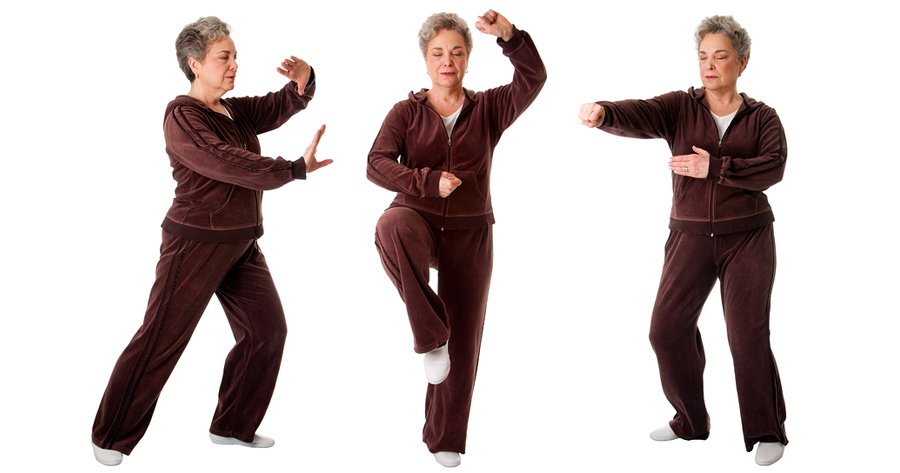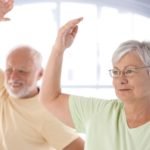It seems that Western medicine is finally catching up with the Orient, at least as far as the treatment of arthritis is concerned. To relieve arthritis suffering, Johns Hopkins Arthritis Center recommends yoga, and WebMd touts the benefits of Tai Chi. According to these sources, both yoga and tai chi increase muscle strength, flexibility, and balance — all of which are essential to relief from arthritis.
Osteoarthritis, the most common form of the disease, usually occurs in older people as a result of wear and tear on the joints. The condition tends to affect large joints such as knees and hips, and it gets worse over time as the cartilage in the joints wears down from continued use. Rheumatoid arthritis, on the other hand, affects the tissues surrounding joints. It’s an inflammatory condition that tends to attack smaller joints such as those of the hands and feet. Rheumatoid arthritis results from immune system issues (either autoimmune, bacterial, or viral) that tend to lead to other symptoms, such as fever, profound fatigue, and pain throughout the body. Eventually, the condition can erode and deform the joints.
Because of the pain arthritis causes, sufferers of both varieties tend to avoid moving. The irony is that the body needs to move in order to stay flexible, and so the less arthritis sufferers engage in movement, the stiffer they get. It’s a Catch-22 situation. Moving causes pain, but ultimately, not moving causes stiffness, which causes yet more pain. Plus, lack of activity leads to loss of muscle strength and reduced balance.
That’s where yoga and tai chi come in. If your idea of yoga involves diaper-clad men twisted into knots or lithe young bodies contorted into impossible positions, think again. Yoga for beginners should be quite gentle and stress-free. In traditional yoga practice, the emphasis is on the joining of mind and spirit that accompanies the practice rather than strictly on the physical aspects. Yes, you do need to learn a series of postures, or asanas, and breathing exercises, but these practices improve not only physical, but also mental well being. Johns Hopkins cites 75 scientific trials that support the benefits of yoga. Their website says, “In summary, yoga is associated with a wide range of physical and psychological benefits that may be especially helpful for persons living with a chronic illness.” The website also claims that the American College of Rheumatology treatment guidelines recommend physical activity as “an essential part of the effective treatment of osteoarthritis (OA) and rheumatoid arthritis (RA),” noting that the psychological benefits of yoga may provide an additional boost to the immune system and overall well-being.
Tai Chi provides benefits with even less stress than yoga. If you’ve never done tai chi, the practice consists of gentle, repetitive movements, stances, and breathing that get the body’s energy flowing more abundantly and freely. WebMd cites certified tai chi Instructor Cate Morrill, who claims that in her classes for seniors, “after five, 10, 15 minutes of tai chi, they report having pain relief.” One of the great things about tai chi is that it targets many different joints and muscle groups. Merrill says that her students will do up to 20 movements in an hour, repeating each one for around two minutes.
Others in the medical world seem to be embracing practices like tai chi. For instance, Dr. Raymond Gaeta, who directs pain management services at Stanford Hospital & Clinics, says that these practices “are intended to maintain muscle tone, strength, and flexibility, and perhaps even spiritual aspects like mindfulness – focusing in the moment, focusing away from the pain.” And Dr. Parag Sheth, MD, assistant professor of rehabilitation medicine at Mt. Sinai Medical Center in New York, adds, “There’s logic in how tai chi works. Tai chi emphasizes rotary movements — turning the body from side to side, working muscles that they don’t use when walking, building muscle groups they are not used to. If they have some strength in those support muscles — the rotators in the hip — that can help prevent a fall.”
There is some good scientific research to support the claims about tai chi. A number of studies have showed that arthritis-suffering seniors who took tai chi classes experienced improved flexibility and attitude, better ability to get around, improved ability to perform physical activity (even if it was vigorous), stronger muscles, improved range of motion, and reduced pain.
So grasshopper, if you suffer from arthritis, the moral of the story is get off your duff and move. Fight the urge to give in to the pain and stiffness and become sedentary. You’ll certainly feel better if you develop a discipline such as yoga or tai chi and practice it in a careful, gentle, and consistent way. The Johns Hopkins site also recommends dance, so if you prefer to boogie, go for it. If you do opt for yoga, find a class meant for seniors taught by an instructor with experience working with people who have arthritis. Make sure you choose a gentle yoga or yoga for beginners class, arrive early for the first session, and talk to the instructor about your condition to make sure the class will be appropriate.
The same rules apply to tai chi. You need an instructor who has experience working with people in your boat. “Elderly students need an instructor who can correct their posture,” says Cate Morrell. “If someone has severe arthritis in the left knee, they may not be able to do moves like someone who has a light case of arthritis. It’s the instructor’s job to modify movement to make it as safe and painless as possible for each student … to select moves that are most appropriate.”
The alternative community has known about these things for years, but with even the traditional medical community now embracing these practices, it’s time to pay attention instead of merely waiting for the next best pill. And be sure and check out the Baseline of Health Program for arthritis.
:hc












I have been doing Tai Chi for 2 years now and recently I realised that my headaches and neck pain which had been fairly constant in my life have almost disappeared! I can’t put it down to anything more than the regular Tai Chi class. Highly recommended.
A rthritis is a disorder characterized by painful and swollen joints. I agree with you that a proper light exercise like tai chi and yoga can help curing arthritis.
Does anybody know if they
Does anybody know if they offer free classes for low income individuals like me? I live in the Bronx area if not what are the fees and where can I find one in the Bronx NY 10467 area. I must try been through all opoids and antinflammatory and got dependant of the opoids now I’m on tramadol which gave me a pain reaction in my legs was horible now I’m afraid to take it and my next Dr.s appt is in 2 months and I’m tired of being in pain. Now I have dropped wrists and muscle spasms that contort my fingers and toes. Please contact me at your earliest convenience in need of help. Thank you and have a blessed day.♥
I definitely have improved
I definitely have improved flexibility and balance simply by doing Tai-Chi moves in combination with Yoga exercises.
Becoming aware of my abilities & limitations to perform stretching and slowly moving poses in different ways without joint stress allows me more motion. I live with severe RA and through these wonderful poses, my life with this chronic disorder is more manageable. RA takes a back seat and I intend to keep it at bay.Jon impressed upon me that by maintaining the body holistically balanced allows the body to heal itself; this I attest is true for me.
Cecilia Alcantar
Dallas Texas